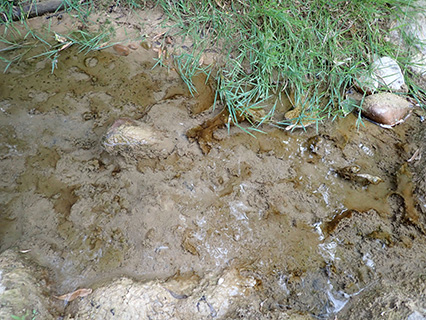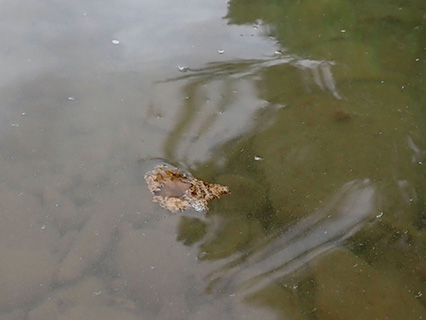This webpage is updated monthly with information provided by Zion National Park. The Utah Division of Water Quality does not routinely conduct HAB sampling within the Virgin River Watershed. If you have additional questions, please contact Zion National Park by calling (435) 772-3256.
This webpage is updated with information provided by Zion National Park.
Updates
La Verkin Creek:
Check for mats
Monitoring for harmful algae on July 8, 2025
Harmful algae mats (benthic cyanobacteria) may be present. Avoid touching or disturbing algae mats. Avoid primary contact recreation (swimming and submerging the head) when recreating in this area. Do not drink in-stream water anywhere in the park. If you must filter water, do so directly from a spring source.
Lower Virgin River:
Check for mats
Monitoring for harmful algae on July 8, 2025
Harmful algae mats (benthic cyanobacteria) may be present. Avoid touching or disturbing algae mats. Avoid primary contact recreation (swimming and submerging the head) when recreating in this area. Do not drink in-stream water anywhere in the park. If you must filter water, do so directly from a spring source.
Lower Virgin River:
Looks Good
Monitoring for harmful algae on June 23, 2025
GOOD NEWS: Our monitoring team did not see any visible signs of harmful algae mats (benthic cyanobacteria) at the recreational sites they visited. However, mats may be present at other sites or regrow before our next visit. Know what to look for and check before letting children or pets in the water.
North Creek (including “The Subway”):
Warning Advisory
Recent monitoring on June 17, 2025
Harmful algae mats (benthic cyanobacteria) are present and producing toxins. Avoid touching or disturbing algae mats. Avoid primary contact recreation (swimming and submerging the head) when recreating in this area. Do not drink in-stream water anywhere in the park. If you must filter water, do so directly from a spring source.
North Fork of Virgin River (including “The Narrows”):
Warning Advisory
Recent Monitoring on June 16, 2025
Harmful algae mats (benthic cyanobacteria) are present and producing toxins. Avoid touching or disturbing algae mats. Avoid primary contact recreation (swimming and submerging the head) when recreating in this area. Do not drink in-stream water anywhere in the park. If you must filter water, do so directly from a spring source.
La Verkin Creek:
Health Watch
Recent Monitoring on June 16, 2025
Harmful algae mats (benthic cyanobacteria) may be present. Avoid touching or disturbing algae mats. Avoid primary contact recreation (swimming and submerging the head) when recreating in this area. Do not drink in-stream water anywhere in the park. If you must filter water, do so directly from a spring source
Lower Virgin River:
Looks Good
Monitoring for harmful algae on June 6, 2025
GOOD NEWS: Our monitoring team did not see any visible signs of harmful algae mats (benthic cyanobacteria) at the recreational sites they visited. However, mats may be present at other sites or regrow before our next visit. Know what to look for and check before letting children or pets in the water.
North Creek (including “The Subway”):
Warning Advisory
Monitoring for harmful algae on October 1, 2024
Harmful algae mats (benthic cyanobacteria) are present and producing toxins. Avoid touching or disturbing algae mats. Avoid primary contact recreation (swimming and submerging the head) when recreating in this area. Do not drink in-stream water anywhere in the park. If you must filter water, do so directly from a spring source.
North Fork of Virgin River (including “The Narrows”):
Warning Advisory
Monitoring for harmful algae on October 1, 2024
Harmful algae mats (benthic cyanobacteria) are present and producing toxins. Avoid touching or disturbing algae mats. Avoid primary contact recreation (swimming and submerging the head) when recreating in this area. Do not drink in-stream water anywhere in the park. If you must filter water, do so directly from a spring source.
La Verkin Creek:
Health Watch
Monitoring for harmful algae on October 2, 2024
Harmful algae mats (benthic cyanobacteria) may be present. Avoid touching or disturbing algae mats. Avoid primary contact recreation (swimming and submerging the head) when recreating in this area. Do not drink in-stream water anywhere in the park. If you must filter water, do so directly from a spring source.
Since July 2020, the National Park Service (NPS) in Zion National Park has been monitoring harmful algal bloom (HAB) toxin production on a monthly basis at several water bodies inside the park.
Cyanobacteria and HABs in the Virgin River are different from what is commonly seen in Utah’s lakes and reservoirs. This cyanobacteria grows in mats on the bottom of the riverbed, often attached to rocks or plants. It may be brown, black, tan, or green and comes in a variety of textures.
How can I stay safe while recreating in Zion National Park?
- Check water body conditions before visiting.
- Know what to look for so you can avoid coming into contact with cyanobacterial mats.
- Do not swim or put your head under water. Children are especially vulnerable to accidental exposure.
- Keep dogs on a leash and out of water. Dogs are vulnerable to toxin exposure as they may bite or accidentally eat/drink material from cyanobacterial mats.
- Shower after coming into contact with recreational water.
- Wash hands with clean water before eating or preparing food.
- Do not drink any water from streams or rivers in Zion National Park. There is no known recreational filtration method that can remove these toxins. If you must filter water, get it directly from a spring.
Why are habs in zion national park dangerous?
Cyanobacteria living in the Virgin River (including “The Narrows” and other locations in Zion Canyon) may produce dangerous toxins. These toxins target the liver and nervous system and are dangerous for people and animals.
Toxins can be absorbed through eyes, nose, or mouth by swimming in contaminated water – very small or even invisible pieces of the cyanobacterial growth may contain enough toxin to cause harm.
What are the symptoms of HAB exposure?
Symptoms of toxin exposure include:
- Skin rash
- Salivation
- Drowsiness
- Tingling or numbness,
- Incoherent speech
- Muscle contractions or twitching
- Vomiting and/or diarrhea
If you think you have been exposed, immediately contact the Utah Poison Control Center at (800) 222-1222.
How does Zion National Park determine exposure risk?
The NPS, DWQ, and Utah Department of Health and Human Services have worked to characterize exposure risk from HABs in the Virgin River in order to better compare toxin results to the current DWQ/DHHS HAB Guidance and Recreational Thresholds.
Zion National Park staff rely on three lines of evidence for issuing recreational advisories:
- The presence or absence of known toxin-producing cyanobacteria species.
- The presence or absence of toxins in the water body using SPATT bags.
- ‘Benthic disturbance sampling’ – a process where a water quality scientist walks along a cyanobacterial mat (imitating recreation) and then measures the concentration of toxins produced.





